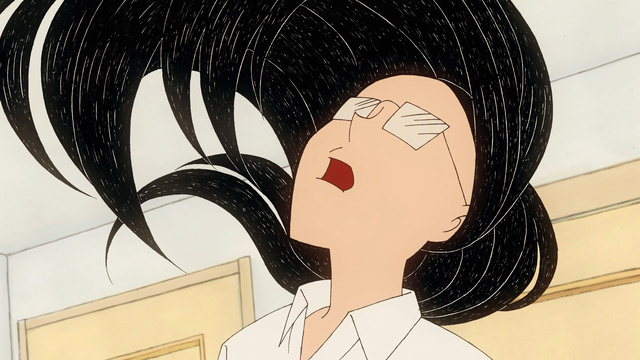On-Gaku: Our Sound
October 3, 2021 · 0 comments
By Andrew Osmond.

On-Gaku: Our Sound has been rightly hailed a landmark in indie anime. It’s a comedy film, deadpan enough to impress Bill Murray. It devises its own style without any of the cutesy panderings or manga-style tics in so much anime. Actually, the film is based on a manga, but a self-published one. Most of the film’s forty thousand drawings were created by a single person, director Kenji Iwaisawa, who was also On-Gaku’s animation director, writer and editor. That’s indie for you.
And yet, On-Gaku won’t feel that unfamiliar to fans of commercial anime. It’s about teenage Japanese students, in an average Japanese school, in an average Japanese town, who get together and make music. Granted, On-Gaku’s musicians are boys, led by a bald-headed, stoneface type with a squiggle moustache. Like the director, he’s called Kenji. He looks and feels like a close relative of Saitama, the world’s most nonchalant superhero in One Punch-Man. That was another property that started as an indie comic, even if it went commercial. Music shows in commercial anime often favour cute girls, though you don’t have to look far for boy musicians, like those in Beck and Shinichiro Watanabe’s Kids on the Slope.
Admittedly, Kenji’s journey to musical greatness in On-Gaku is far more absurd than them. The film’s whole charm is wrapped up in its cheery unbelievability. After Kenji witnesses a minor crime – made funnier by the fact it happens almost completely off-screen, relayed by voices like a radio comedy – he finds himself in possession of a hefty guitar. But Kenji’s so musically illiterate that he doesn’t even realise it’s a bass guitar, until one of his two minions tells him.
And so, this Spinal Tap-type trio start making beautiful music together – or at least the kind of monotonous, bottom-notes drone that a torturer could play for hours to drive prisoners insane. In fairness, the boys’ “sound” is impeccably timed, even melodic, like a very primitive relative of the clacking wooden percussion that Geinoh Yamashirogumi used to hypnotise us in Akira. Actually, Kenji’s band sounds much more like Akira when we hear it through the ears of one of the band’s first groupies. For this innocent listener, the music conjures up psychedelic visions involving woodblock prints, the Hindenburg, and the artwork for Tubular Bells.

But we only really hear the boys’ “sound” in the film’s finale. By this time, a very unexpected instrument has taken a starring role; one character has had a one-eighty degree personality transformation; and the spirit of Woodstock has seeped magically into the film’s mundane world. Believe me, it’s worth the wait.
But it may well be the littler touches that charm you, like the TV cartoon Kenji watches about a horrid children’s character that just wants to squeeze you, or the extended scenes of characters walking through nonchalantly beautiful scenery. The teenage characters have obviously adult voices, a device going back to Britain’s Dennis Potter but used to more comic effect in Isao Takahata’s Chie the Brat and American adult animation (Family Guy, Big Mouth).
Iwaisawa relied heavily on rotoscoping – this video extract demonstrates how much it was used. Yet the film feels different from other overtly “traced” animation, such as The Case of Hana and Alice or – taking a musical example – Ralph Bakshi’s 1981 American Pop. The human movements are even and “limited.” Perhaps more importantly, the character designs are stripped back to minimal lines.
Look at Kenji’s face, on which his “moustache” is a childish doodle, and his eyes are drawn crescents which cross carelessly at the corners. Even in the final music performance, the most obvious sign that the pictures are traced is in the handheld camerawork, in unplugged framing more than unplugged bodies.
As mentioned earlier, the indie comic One-Punch Man ended up spawning a commercial franchise. In anime, the most famous artist who created a film largely single-handed was Makoto Shinkai with Voices of a Distant Star, and look where he’s ended up. Perhaps On-Gaku’s director Iwaisawa will go the same way, and yet judging by the sheer quirk of this film, it seems unlikely.
Perhaps Iwaisawa will end up like America’s Bill Plympton, who’s also celebrated for creating his films, including features, also entirely solo. Plympton was offered work at Disney after his first successes, but he turned the Mouse down. For more than thirty years, he’s been following his own proudly independent course. Perhaps one day it will cross with Iwaisawa’s.
Andrew Osmond is the author of 100 Animated Feature Films. On-Gaku: Our Sound is released in the UK by Anime Limited.
Leave a Reply